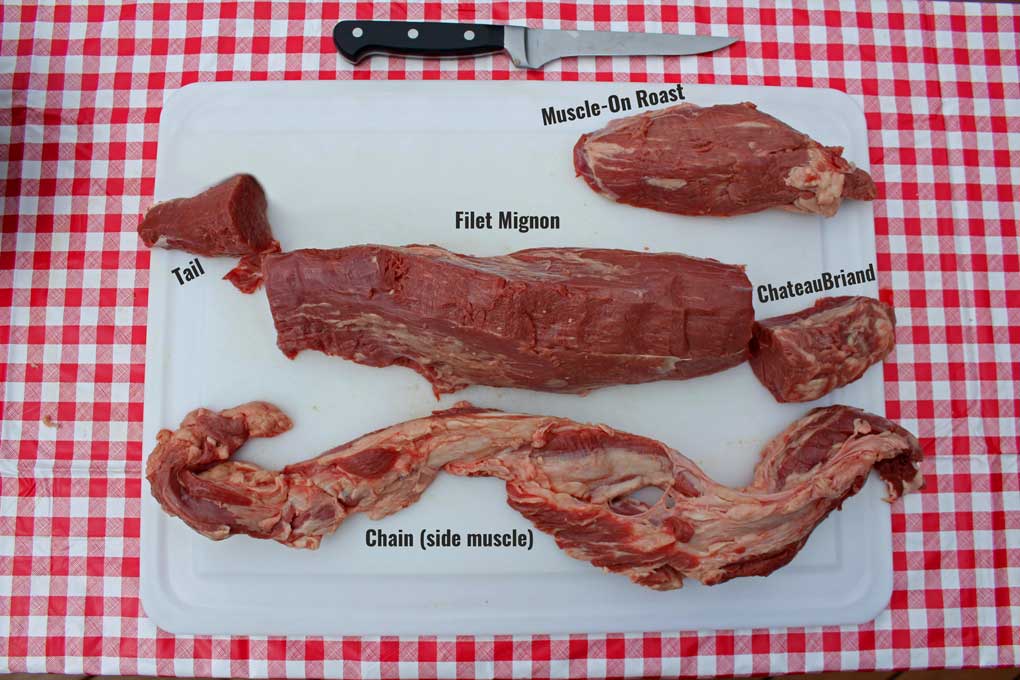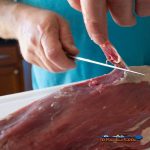You’ve come to the right place if you want to learn a new cooking technique or want to prepare a tenderloin roast or filet steaks for a special occasion. We’ll go over the procedures and offer some advice on how to trim beef tenderloin consistently excellently. So, grab your knife, and let’s get started!.
There is no better way to save money for the holidays than by purchasing a whole cut of beef and doing your own trimming. A tenderloin roast is consistently one of the most expensive cuts of beef due to its popularity as one of the most common cuts for special occasions and the holidays and its most tender muscle. And we’re going to walk you through the entire process of trimming a beef tenderloin.
Although trimming a beef tenderloin may initially seem difficult, with some practice and the right equipment, it’s actually quite simple. In addition to saving money on pricey cuts like filet mignon and chateaubriand, trimming your own tenderloin is a great way to ensure a lovely appearance and even cooking.
What is Beef Tenderloin?
One of the most expensive cuts of beef you can get from a cow is the tenderloin. Because it is hidden inside the hindquarter from a region known as a short loin or the psoas major, the muscle is also the most delicate. This implies that it isn’t frequently used, which makes it tender.
Whole Tenderloin – Understand the Muscle
Before you start, it’s crucial to be aware of what to look for when the tenderloin is removed from its packaging. The image below shows a whole beef tenderloin that is clean and dry right out of the package.

I told you so, untrimmed tenderloin is not at all appetizing. Rather gnarly, ain’t it?.
The whole beef tenderloin is shown in the photo diagram below, clean and cut, with the silver skin removed. This will help you understand where the muscles come from.

You need to be aware of the following three parts of a beef tenderloin:
- Tenderloin roasts should not be thrown away because they are high-quality meat.
- The tail, the filet mignon, and the CheatauBriand are the three distinct parts of the tenderloin. All exceptional meat with varying texture!.
- The Chain (side muscle) is covered in thick, fatty connective tissue and silverskin. It contains some tasty meat that can be removed and saved.
When cutting a tenderloin, use two bowls: one for the extra fat and silverskin, and one for the good meat you can save for later. The flavorful scrap meat can be ground into delicious hamburgers, stir-fries, or fajitas.
We made burgers from the ground up tenderloin meat. The hamburger patties melt in your mouth. I’m excited to try some more scraps that we have in the freezer in fajitas or stir-fries, but it will be difficult to resist making another burger with them.
What You’ll Need To Cut Whole Beef Tenderloin
- Sturdy Cutting Board
- Extra-sharp Knife (a boning knife works best)
- Two bowls: one for reserving scraps and the other for discarding trash
Remove The Package and Prepare For Cutting
To prevent messy spills from the “purge” (water and meat proteins that drain from meat), it is best to open the package in the kitchen sink. Hold the package as vertically as you can for the cleanest removal. Make a slit in the cryovac package’s top large enough for the tenderloin to exit. Pull the tenderloin out slowly, letting the purge remain in the package’s bottom. If the purge is still inside the package, throw it away or pour it down the sink.
Meat rinsing is a personal choice and a contentious subject. Some meats were rinsed to remove the “purge,” which occasionally can become stagnant if the package is getting close to the end of its shelf life.
Pat the meat dry with paper towels. Considering how slippery wet meat can be, this makes it safer to cut.
View the video of David cutting a whole beef tenderloin we made here.
How To Cut Whole Beef Tenderloin

Step 2: Remove The Chain

The tenderloin has a fatty butt end and a tapered end. The tenderloin has a thin strip of loosely adhered meat and fat running the length of it. This trip is called the “chain. You will observe that it doesn’t take much to loosen it and pull away from the tenderloin if you grab it with your hands. To fully separate it, just a few quick strokes of the knife are required.
By trimming away the fat and any connective tissue, you can save the meat from the chain for the other dishes we mentioned earlier.
Now you have the main tenderloin to work with.
Step 3: Trim Off The Tail

Step 4: Excess Fat and Silverskin
The tenderloin has “silver skin,” a white sheen of connective tissue. “Silverskin is incredibly tough and won’t crumble while being cooked. To ensure that the tenderloin is as tender as possible, it is crucial to completely remove the silver skin.

Carefully pull the silverskin away from the meat as you run the tip of your knife along the meat’s surface to remove it. Because of this, it’s crucial to use a very sharp knife when slicing the tenderloin.
Trimming away any pockets of extra fat is crucial when removing the silverskin. Melted fat in moderation is acceptable, but too much can dilute the flavor of the meat.
Step 5: Cut Or Tie The Narrow End (ChateauBriand)

You can either tuck the tenderloin under and tie it up with butcher’s twine to make it more uniform for even cooking.
When you have leftover meat, trim off the narrow section (also known as the “ChateauBriand”) and keep it.

The first beef tenderloin David and I cut was tucked and tied. Although it’s not difficult to do, there are a lot more steps involved than simply cutting it off and grilling it. However, “Tournedos” (meat cut) are produced from this small end of the tenderloin.
If you were to order tournedos in a French restaurant, it would be absurdly expensive, extremely lean, and tender.
You must at least once try grilled tournedos tenderloin steaks because they are incredible!

What To Do With Beef Tenderloin
When you have the beef tenderloin, you can make smoked beef tenderloin on the grill by doing a reverse-sear [LIKE THIS].
you can slice it into 1 ½ to 2-inch medallions, filet mignon steaks, and grill them using this recipe from Weber.com
We hope that by demonstrating to you how to cut a whole beef tenderloin, you’ll be able to feed the important people in your life while also saving money.


How To Cut Whole Beef Tenderloin
- Large Cutting Board
- Sharp Knife
- Two bowls: one for reserving scraps and the other for discarding trash
- Disposable Gloves
Step 1: Remove the Muscle-On Roast
- The tenderloin’s end contains the muscle-on roast.
Step 2: Remove The Chain
- The tenderloin has a tapered end and a fatty end. The tenderloin has a thin strip of loosely adhered meat and fat running the length of it. This trip is called the “chain”. It doesn’t take much to loosen it and pull away from the tenderloin if you grab it with your hands. It can be fully detached with just a few light strokes of the knife. Now you have the main tenderloin to work with.
Step 4: Excess Fat and Silverskin
- A white sheen of connective tissues known as “silverskin” covers the tenderloin. Due to its extreme toughness, silverskin won’t disintegrate while being cooked. The tenderloin should have all of the silverskin removed to make it as tender as possible. Pull the silverskin away from the meat while carefully gliding the knife along the meat’s surface to remove it. Because of this, it’s crucial to use a very sharp knife when slicing the tenderloin. Trimming away any pockets of extra fat is crucial when removing the silverskin. Melted fat in moderation is acceptable, but too much can dilute the flavor of the meat.
Step 3: Trim Off The Tail
- To make the tenderloin more uniform for even cooking. When you have enough meat left over, use the knife to remove the tail and save it.
Step 5: Cut Off the Tip (ChateauBriand) or Tie it
- You can either tuck the tenderloin under and tie it with butcher’s twine or cut off the narrow portion (also known as the “ChateauBriand”) and save it when your salvaged meat is done cooking. (see notes) .
How To Butcher A Beef Tenderloin
FAQ
What cuts do you get from a whole beef tenderloin?
Butt, center-cut, and tail are the tenderloin’s three primary cuts. The large end of the tenderloin from a steer or heifer is used to make the filet mignon. In the U. S. supermarkets and eateries frequently sell the tenderloin’s large and central ends as filet mignon.
